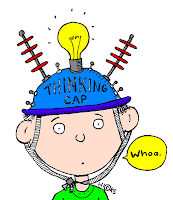We want to teach students to think logically and critically and
not accept information as fact just because someone tells them it is so. We
also want them to go beyond the memorization of facts and be able to analyze,
evaluate, and apply what they learn to their own lives. The ability to think
critically helps one to make thoughtful decisions about school work,
directions in life, friends, politics, etc.
While the development of critical thinking skills is vital
for all young people, it is especially important for gifted students. There
are many definitions of critical thinking. These include the ability to
- evaluate information and opinions in a systematic, purposeful, efficient manner
- solve complex real world problems
- generate multiple (or creative) solutions to a problem
- draw inferences
- synthesize and integrate information
- distinguish between fact and opinion
- predict potential outcomes
- evaluate the quality of one's own thinking
The incorporation of critical thinking skills can be a tool
used to increase complexity as teachers differentiate curriculum for gifted
students.
While it is important that critical thinking be taught in
the schools, it is also very important that it be developed at home.
There are two well-recognized systems of questioning that
have been developed to teach critical thinking: Bloom’s Taxonomy and Richard
Paul’s Socratic Questions. These questioning techniques can be incorporated
into both school work and into discussions at home.
Benjamin Bloom created a hierarchical taxonomy of
questioning techniques from the very basic levels of knowledge through
analysis, synthesis, and evaluation questions. In the 1990’s, his taxonomy was
revised. Here is a list of well-constructed question-starters using Bloom’s Revised Taxonomy that I would highly recommend. Remember
to ask students questions from all levels—not just the complex questions.
Richard Paul’s Six Types of Socratic Questions
offers another format of thought-provoking questions that are divided into
categories. This is an approach that is different from Bloom’s. These questions
are used to
- clarify
- probe assumptions
- probe reasons and evidence
- explore viewpoints and perspectives
- probe implications and consequences
- ask questions about the question
While the questioning techniques of Bloom’s Taxonomy and
Richard Paul’s Six Types of Socratic Questions can be applied to any subject
that is discussed in school, teachers also need to know that there is
excellent, already-developed curricula incorporating these critical thinking
approaches. The curricula include
- The Great Books Foundation, which provides materials and training for educators and parents to explore literature.
- Excellent language arts, mathematics, science, and social studies units available for grades K-12. These units have been developed by The Center for Gifted Education at The College of William and Mary.
- Math programs such as the EveryDay Math program, developed by the University of Chicago School Mathematics Project promote critical thinking on a daily basis and encourage even very young students to foster a very deep understanding of mathematics. Students who go through this program learn to reason through different approaches in problem solving.

No comments:
Post a Comment
Your comments will be available after approval.